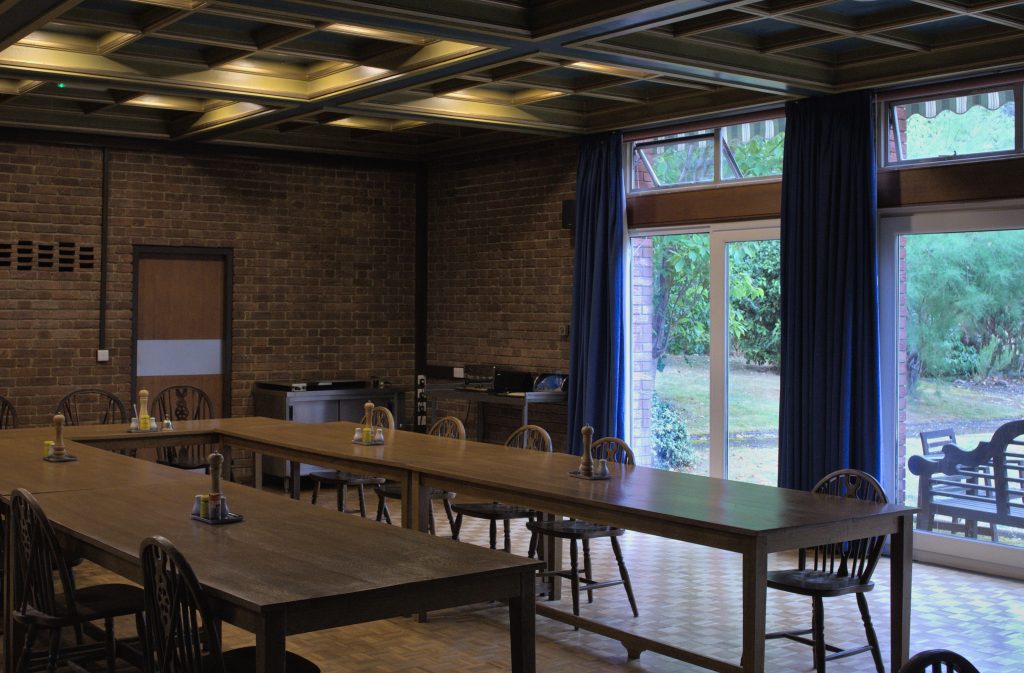The monastery is the house where monks live. Although monasteries are usually in the countryside, away from towns, Ealing Abbey is in a large town. This is not unique, although urban monasteries are less common than rural ones.
Enclosure
A defining aspect of a monastery is the enclosure. This acts as a boundary between the monks and the inside of the monastic area on the one hand, and the outside world on the other. The enclosure creates the space for monks to have prayerful peace. Inside the enclosure are the monks’ living quarters, a chapel, and a garden. Usually, most monastic working spaces are also inside the enclosure.
In some rural monasteries, monks rarely leave the enclosure. Chapter 67 of the Rule of St Benedict suggests monks who leave the enclosure should be punished. When a monastery such as Ealing runs a parish, it is necessary for monks to leave the enclosure more often. In some ways, this can make the monastic self-discipline both more difficult and more necessary.
The Abbot
The person in charge of the monastery is the abbot or the prior. Ealing has been an abbey with an abbot since 1955; before that it was a priory with a prior. The word ‘superior’ is sometimes used to mean abbot or prior. The abbot has almost complete authority in the monastery, although most major decisions require a vote of the community. One of the monastic vows is obedience to the abbot. The abbot is easily identified because he wears a cross around his neck.
Most monasteries, including Ealing, have a prior as well as an abbot. The prior in an abbey is a deputy to the abbot. (In a priory, the prior is the superior.) Usually, the prior will also have specific responsibilities.
Living
When St Benedict wrote his Rule, he said monks should sleep in dormitories. Now most monks sleep in their own rooms, sometimes called cells. Hermits live alone and when monks have their own cells they can live closer to that lifestyle. Some of the very earliest monks may also have lived in cells rather than dormitories.
A monastery will have a refectory, where the monks eat, and a calefactory, which is similar to a common room. Meals are usually eaten in silence, with all the monks sitting down together. One monk will read aloud from a book while the rest are eating. Another monk will act as a waiter or server. The reader and server eat their meal after everyone else. The calefactory is where monks can chat to each other, usually after meals.
Studying
An important building in all monasteries is the library. Study is an important part of a monk’s life. Many monks study for the priesthood and in the English Benedictine Congregation nearly all do. Besides that, monks may take further studies. Study topics include Scripture, liturgy, Church history, monasticism, philosophy, and other topics in theology. Our library is well-equipped for all these.
As well as our own studies, the Benedictine Institute provides courses for other people on liturgy, Latin, spirituality, icon painting, and other subjects with a monastic link.
Praying
Although it is possible to pray anywhere, some places are better for prayer than others. Monks will often pray in their rooms. There is also a small chapel in the monastery. This is used for the daytime offices of the Divine Office, Compline on Sundays, and sometimes for other Hours. In addition, monks will often go in there to have some quiet prayer time.
The house chapel, as is common with religious orders, is simply furmished, without many statues or other artworks.
The Garden
All monasteries have some garden space. Many monasteries, especially rural ones, have large grounds, often including farmland as well as gardens. Ealing has a relatively small garden. Despite (or because of) that, the garden is well-arranged and visitors have often complimented us on our garden. Sadly, our gardening expert, Dom James Leachman, passed away in August 2021. His knowledge of gardening, and his ability to identify almost every type of plant and animal, are greatly missed.
Some older information about the garden is here.





